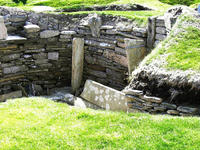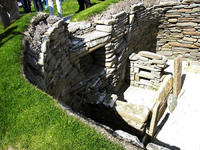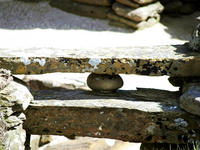You are in: Europe -> United Kingdom. Scotland -> Heart of Neolithic Orkney, and traditional search or Image Gallery will yield results of this site only
Heart of Neolithic Orkney
| Site number: | 514 |
|
| Type of site: | Cultural | |
| Date: | Neolithic | |
| Date of Inscription: | 1999 | |
| Location: | Europe, United Kingdom of Great Britain and Northern Ireland | |
Up to 75 images are shown here. Click on each for more details or on Image Gallery for more images.
| Description: | The group of Neolithic monuments on Orkney is made up of a great chambered tomb known as the Maes Howe, two ceremonial stone circles - the Stones of Stenness and the Ring of Brodgar and Skara Brae settlement, accompanied by several unexcavated burial, ritual and settlement sites. The group represents a chief prehistoric cultural setting which provides a vivid portrayal of life in this northern Scotland’s remote archipelago some 5,000 years ago. --WHMNet paraphrase from the description at WHC Site, where additional information is available. | |
| Heart of Neolithic Orkney refers to a group of Neolithic monuments found in the Scottish island of Orkney. The name was adopted by UNESCO when it proclaimed these sites as a World Heritage Site in 1999. The site of patrimony currently consists of four sites: Maeshowe (It gives its name to the Maeshowe type of chambered cairn, which bears no similarities to any other known chambered cairn design, either in Orkney or elsewhere. Built of 30 tons of sandstone, Maeshowe is one of the largest tombs in Orkney. It is aligned so that its central chamber is illuminated on the winter solstice. Built originally by grooved ware people, the site is close to several other significant ancient monuments thought to be contemporary with Maeshowe.) Standing Stones of Stenness (It is sited on a promontory at the south bank of the stream that joins the southern ends of the sea loch Loch of Stenness and the freshwater loch Loch of Harray. The name, pronounced stane-is, comes from Old Norse meaning stone headland. The stream is now bridged, but at one time was crossed by a stepping stone causeway, and the Ring of Brodgar lies about 1.2 km (3/4 mile) away to the north-west, across the stream and near the tip of the isthmus formed between the two lochs. Maeshowe chambered cairn is about 1.2 km (3/4 mile) to the east of the Standing Stones of Stenness and several other Neolithic monuments also lie in the vicinity, suggesting that this area had particular importance.) Ring of Brodgar (The ring of stones stands on a small isthmus between the Lochs of Stenness and Harray. The centre of the circle has never been excavated by archaeologists and scientifically dated, but it is thought that the stone circle was constructed around 2500 BC, and therefore broadly contemporary with Stonehenge and many other ancient sites in the British Isles and Europe. The circle is 104 metres in diameter, and the third largest in the United Kingdom. The henge originally comprised 60 stones, of which only 27 remained standing at the end of the 20th century. The stones are set within a circular ditch up to 3 metres deep and 9 metres wide that was carved out of the solid bedrock by the ancient residents.) Skara Brae ( It consists of ten clustered houses, and was occupied from roughly 3100-2500BC. It is Europe's most complete Neolithic village.) --Wikipedia. Text is available under the Creative Commons Attribution-ShareAlike License. | ||
| Source: | http://whc.unesco.org/en/list/514 | |
| Reference: | 1. UNESCO World Heritage Center, Site Page. | |




















































